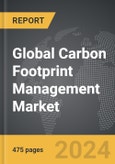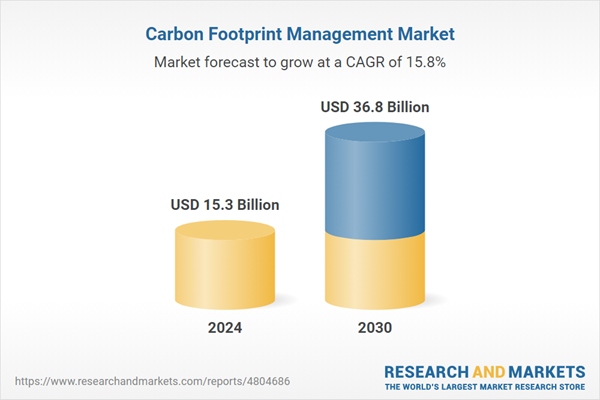Global Carbon Footprint Management Market - Key Trends & Drivers Summarized
Carbon footprint management involves tracking, measuring, and reducing the amount of carbon dioxide (CO2) and other greenhouse gases emitted directly or indirectly by an organization, product, or individual. This process is crucial for mitigating climate change and aligning with global sustainability goals. Carbon footprint management encompasses various strategies, such as improving energy efficiency, transitioning to renewable energy sources, enhancing waste management practices, and implementing carbon offset programs. Organizations employ specialized software and tools to quantify emissions, set reduction targets, and monitor progress, ensuring compliance with environmental regulations and standards.The development of carbon footprint management practices has been driven by the increasing awareness of climate change and the need for sustainable business operations. Technological advancements in data analytics and IoT have enhanced the ability to accurately measure and monitor emissions across supply chains and production processes. The integration of AI and machine learning in carbon management software allows for real-time data analysis, predictive modeling, and automated reporting. Additionally, the rise of corporate sustainability initiatives and regulatory pressures has led to the adoption of carbon footprint management as a critical component of environmental, social, and governance (ESG) strategies.
The growth in the carbon footprint management market is driven by several factors. Firstly, the growing concern about climate change and the need to reduce greenhouse gas emissions are major drivers for adopting carbon management solutions. Secondly, stringent environmental regulations and policies are compelling organizations to monitor and manage their carbon footprints. Thirdly, advancements in technology, such as AI, IoT, and big data analytics, are enhancing the effectiveness and efficiency of carbon footprint management tools. Additionally, the increasing demand for transparency and accountability in corporate sustainability practices is driving the adoption of comprehensive carbon management systems. Lastly, the rise of green financing and investment criteria that prioritize low-carbon operations is encouraging businesses to adopt robust carbon footprint management practices to attract sustainable investments and improve their market competitiveness.
Report Scope
The report analyzes the Carbon Footprint Management market, presented in terms of market value (USD). The analysis covers the key segments and geographic regions outlined below.- Segments: Component (Solutions, Services); Deployment (Cloud Deployment, On-Premise Deployment); Vertical (Energy & Utilities Vertical, Manufacturing Vertical, Transportation & Logistics Vertical, Residential & Commercial Buildings Vertical, Other Verticals).
- Geographic Regions/Countries: World; USA; Canada; Japan; China; Europe; France; Germany; Italy; UK; Rest of Europe; Asia-Pacific; Rest of World.
Key Insights:
- Market Growth: Understand the significant growth trajectory of the Solutions Component segment, which is expected to reach US$20.8 Billion by 2030 with a CAGR of 14.5%. The Services Component segment is also set to grow at 17.7% CAGR over the analysis period.
- Regional Analysis: Gain insights into the U.S. market, valued at $4.4 Billion in 2024, and China, forecasted to grow at an impressive 19.2% CAGR to reach $4.4 Billion by 2030. Discover growth trends in other key regions, including Japan, Canada, Germany, and the Asia-Pacific.
Why You Should Buy This Report:
- Detailed Market Analysis: Access a thorough analysis of the Global Carbon Footprint Management Market, covering all major geographic regions and market segments.
- Competitive Insights: Get an overview of the competitive landscape, including the market presence of major players across different geographies.
- Future Trends and Drivers: Understand the key trends and drivers shaping the future of the Global Carbon Footprint Management Market.
- Actionable Insights: Benefit from actionable insights that can help you identify new revenue opportunities and make strategic business decisions.
Key Questions Answered:
- How is the Global Carbon Footprint Management Market expected to evolve by 2030?
- What are the main drivers and restraints affecting the market?
- Which market segments will grow the most over the forecast period?
- How will market shares for different regions and segments change by 2030?
- Who are the leading players in the market, and what are their prospects?
Report Features:
- Comprehensive Market Data: Independent analysis of annual sales and market forecasts in US$ Million from 2024 to 2030.
- In-Depth Regional Analysis: Detailed insights into key markets, including the U.S., China, Japan, Canada, Europe, Asia-Pacific, Latin America, Middle East, and Africa.
- Company Profiles: Coverage of players such as CarbonEES®, Carbon Footprint Ltd., Dakota Software Corporation, EnergyCAP, LLC., ENGIE Impact and more.
- Complimentary Updates: Receive free report updates for one year to keep you informed of the latest market developments.
Some of the 81 companies featured in this Carbon Footprint Management market report include:
- CarbonEES®
- Carbon Footprint Ltd.
- Dakota Software Corporation
- EnergyCAP, LLC.
- ENGIE Impact
- Envirosoft Corporation
- IBM Corporation
- Intelex Technologies Inc.
- IsoMetrix Software
- Locus Technologies
- Native, a Public Benefit Corporation
- SAP SE
- Schneider Electric SE
- Wolters Kluwer N.V.
This edition integrates the latest global trade and economic shifts into comprehensive market analysis. Key updates include:
- Tariff and Trade Impact: Insights into global tariff negotiations across 180+ countries, with analysis of supply chain turbulence, sourcing disruptions, and geographic realignment. Special focus on 2025 as a pivotal year for trade tensions, including updated perspectives on the Trump-era tariffs.
- Adjusted Forecasts and Analytics: Revised global and regional market forecasts through 2030, incorporating tariff effects, economic uncertainty, and structural changes in globalization. Includes historical analysis from 2015 to 2023.
- Strategic Market Dynamics: Evaluation of revised market prospects, regional outlooks, and key economic indicators such as population and urbanization trends.
- Innovation & Technology Trends: Latest developments in product and process innovation, emerging technologies, and key industry drivers shaping the competitive landscape.
- Competitive Intelligence: Updated global market share estimates for 2025, competitive positioning of major players (Strong/Active/Niche/Trivial), and refined focus on leading global brands and core players.
- Expert Insight & Commentary: Strategic analysis from economists, trade experts, and domain specialists to contextualize market shifts and identify emerging opportunities.
Table of Contents
Companies Mentioned (Partial List)
A selection of companies mentioned in this report includes, but is not limited to:
- CarbonEES®
- Carbon Footprint Ltd.
- Dakota Software Corporation
- EnergyCAP, LLC.
- ENGIE Impact
- Envirosoft Corporation
- IBM Corporation
- Intelex Technologies Inc.
- IsoMetrix Software
- Locus Technologies
- Native, a Public Benefit Corporation
- SAP SE
- Schneider Electric SE
- Wolters Kluwer N.V.
Table Information
| Report Attribute | Details |
|---|---|
| No. of Pages | 420 |
| Published | December 2025 |
| Forecast Period | 2024 - 2030 |
| Estimated Market Value ( USD | $ 15.3 Billion |
| Forecasted Market Value ( USD | $ 36.8 Billion |
| Compound Annual Growth Rate | 15.8% |
| Regions Covered | Global |









